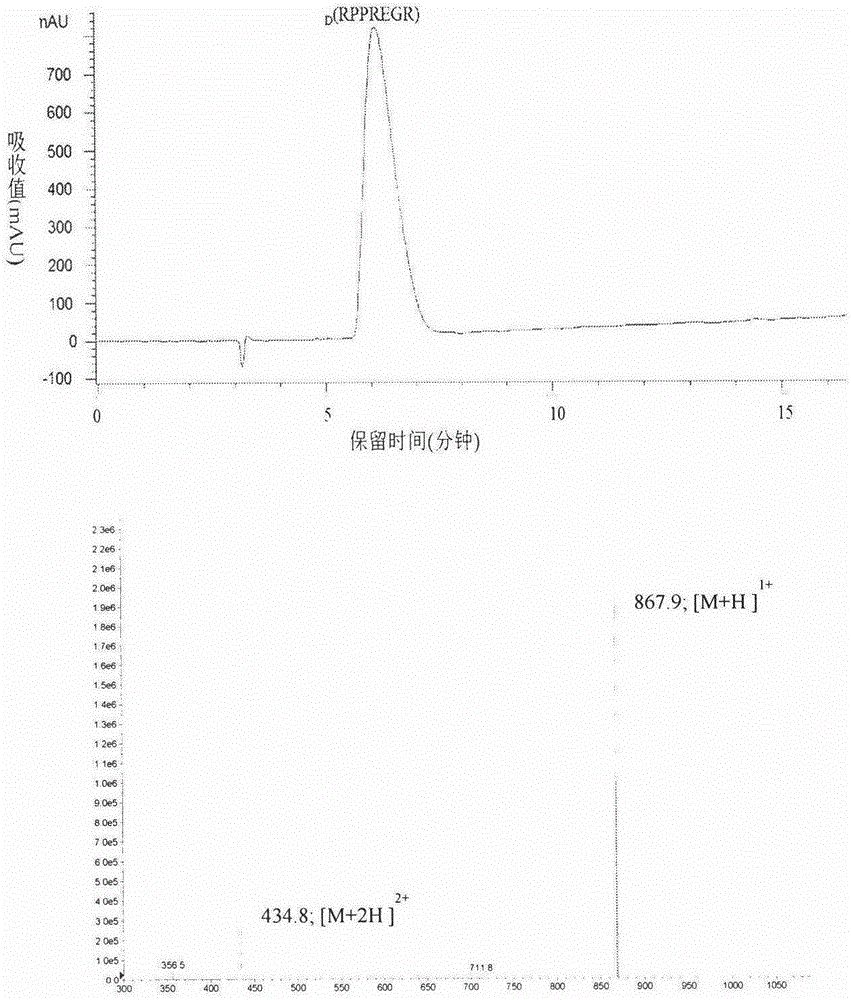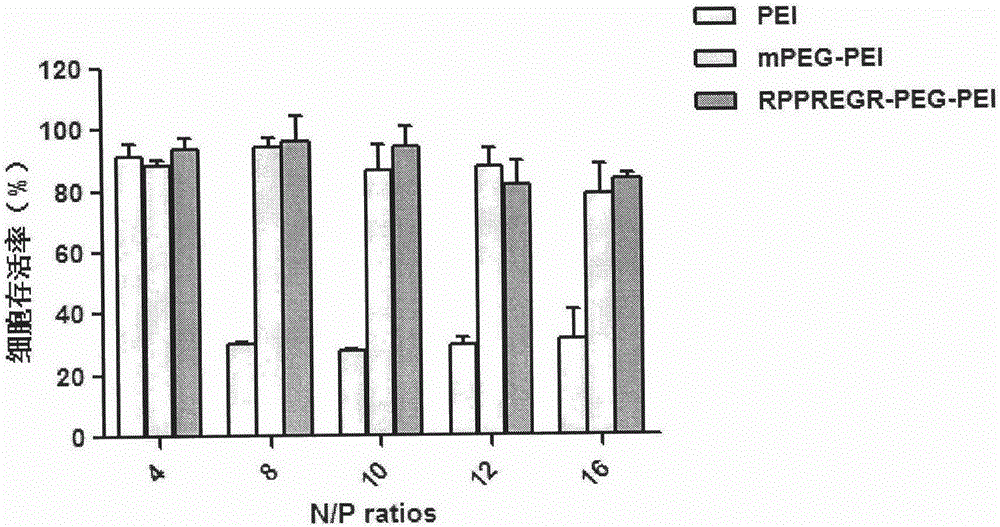D-configuration polypeptide with brain tumor targeting and tumor tissue penetration ability and its gene delivery system
A brain tumor and configuration technology, applied in the field of pharmacy, to achieve the effect of prolonging the survival period and improving the efficiency of gene transfection
- Summary
- Abstract
- Description
- Claims
- Application Information
AI Technical Summary
Problems solved by technology
Method used
Image
Examples
Embodiment 1
[0032] Preparation and characterization of RPPREGR
[0033]Using the solid-phase synthesis method, deprotect the PAM-Boc resin with trifluoroacetic acid (TFA) for 1 minute, twice, and use Boc to protect the D-configuration amino acid to react in turn. The resin was washed with DMF, DCM / MeOH (1 / 1) and dried in vacuo. Put the resin into a polypeptide cutting tube, add an appropriate amount of P-cresol, then pass through HF, stir in an ice bath for 1 hour, remove the HF in the tube under reduced pressure after the reaction, wash the precipitate with ice ether for 3 times, and wash the residual precipitate with 20% acetonitrile After dissolving, spin evaporate, use acetonitrile / water (containing 0.1% TFA) system to separate and purify, HPLC and ESI-MS characterize the purity and molecular weight of RPPREGR, its HPLC spectrum and mass spectrum are as follows figure 1 As shown, the molecular weight of RPPREGR is 866.9, which is consistent with the calculated results.
Embodiment 2
[0035] Preparation of RPPREGR-PEG-PEI
[0036] Dissolve 20mg NHS-PEG-Mal and 11.3mg RPPREGR polypeptide (molar ratio 1:1.3) in 1mL DMF, slowly drop into 300μl DMF, stir at room temperature for 1h, HPLC detects the formation of RPPREGR-PEG-Mal, the above reaction The solution was diluted one-fold with pure water, then transferred to Sephadex G-15 gel column, separated and purified by AKTA Explorer1100 Series [mobile phase pure water; flow rate 1ml / min], and the RPPREGR-PEG-Mal fraction was collected and freeze-dried.
[0037] Dissolve 15mg of PEI in 1.5mL of 0.2M PBS (pH=7.4) buffer solution, adjust the pH to about 7.0 with HCL, and dissolve 8.25mg of RPPREGR-PEG-Mal (molar ratio 1:5) in 0.5mL of 0.2 M PBS (pH=7.4) buffer solution, stirred and added to the above PEI reaction solution, stirred overnight at room temperature, ultrafiltered (Mw=10kDa, AmiconUtro-4mL, Millipore) 5 times, and freeze-dried to obtain RPPREGR-PEG- PEI.
Embodiment 3
[0039] Preparation and Characterization of RPPREGR-PEG-PEI / pDNA
[0040] pGL 4.2 Plasmid solution and carrier material solution were mixed in equal volumes, the final concentration of pDNA was 40 μg / mL, vortexed immediately for 30 s, and left at room temperature for 30 min to obtain a freshly prepared complex solution. The concentration of carrier material depends on N / P, and its calculation formula is N / P=7.53×PEI (g) / DNA (g), the particle size and Zeta potential of each sample were measured with the NanoZS particle size analyzer of Malvern, the results are as follows figure 2 As shown, at NP=12, PEG-PEI / pGL 4.2 and RPPREGR-PEG-PEI / pGL 4.2 The particle size is about 200nm, and the potential is positive.
PUM
 Login to View More
Login to View More Abstract
Description
Claims
Application Information
 Login to View More
Login to View More - R&D
- Intellectual Property
- Life Sciences
- Materials
- Tech Scout
- Unparalleled Data Quality
- Higher Quality Content
- 60% Fewer Hallucinations
Browse by: Latest US Patents, China's latest patents, Technical Efficacy Thesaurus, Application Domain, Technology Topic, Popular Technical Reports.
© 2025 PatSnap. All rights reserved.Legal|Privacy policy|Modern Slavery Act Transparency Statement|Sitemap|About US| Contact US: help@patsnap.com



